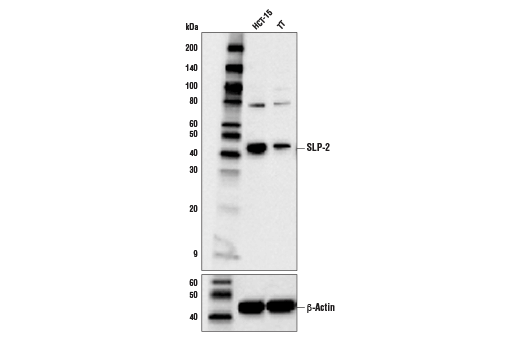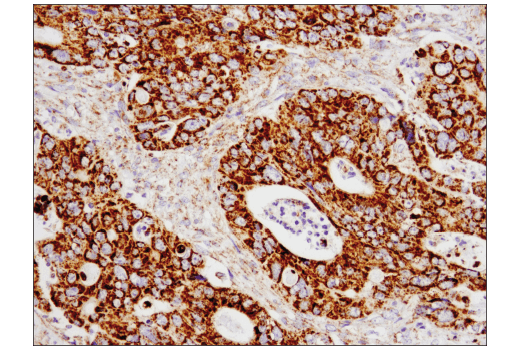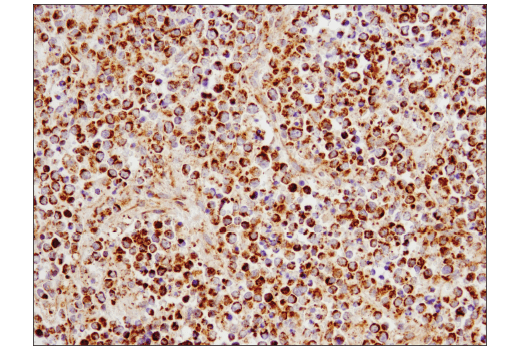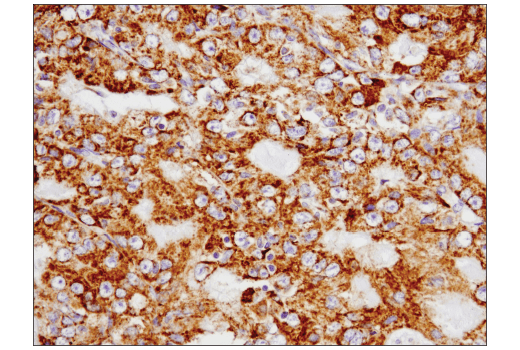WB, IHC-P
H M R
Endogenous
40
Rabbit IgG
#Q9UJZ1
30968
Product Information
Product Usage Information
| Application | Dilution |
|---|---|
| Western Blotting | 1:1000 |
| Immunohistochemistry (Paraffin) | 1:100 |
Storage
Specificity / Sensitivity
Species Reactivity:
Human, Mouse, Rat
Source / Purification
Monoclonal antibody is produced by immunizing animals with a synthetic peptide corresponding to residues surrounding Val182 of human SLP-2 protein.
Background
Stomatin-like protein 2 (SLP-2 and also known as STOML2) is a lipid-anchored mitochondrial protein that is part of a large protein complex that regulates mitochondrial biogenesis and function. Proteomic studies identified SLP-2 as a widely expressed mitochondria-enriched protein (1). As a member of both the stomatin family and stomatin-prohibitin-flotillin-HfLC/K (SPFH) superfamily of proteins, SLP-2 forms large hetero-oligomeric complexes with other mitochondrial proteins, including prohibtin, mitofusin 2, and cardiolipin (2, 3). SLP-2 contains a highly conserved SPFH domain that mediates its ability to associate with the mitochondrial inner membrane and form specialized membrane microdomains. As an inner membrane organizer of other mitochondrial proteins, SLP-2 performs multiple mitochondrial functions, including regulation of mitochondrial biogenesis, energy/calcium homeostasis, translation, and mitochondrial-mediated cellular stress responses (3, 4, 5, 6, 7, 8). Enhanced SLP-2 expression is also associated with several human cancers, including gallbladder, rectal, and gastric cancer (9, 10, 11).
- Da Cruz, S. et al. (2003) J Biol Chem 278, 41566-71.
- Hájek, P. et al. (2007) J Biol Chem 282, 5670-81.
- Christie, D.A. et al. (2011) Mol Cell Biol 31, 3845-56.
- Da Cruz, S. et al. (2010) Cell Calcium 47, 11-8.
- Wang, Y. et al. (2009) Cancer Biol Ther 8, 1651-8.
- Christie, D.A. et al. (2012) J Immunol 189, 4349-60.
- Tondera, D. et al. (2009) EMBO J 28, 1589-600.
- Mitsopoulos, P. et al. (2017) PLoS One 12, e0179967.
- Wang, W.X. et al. (2014) Tumour Biol 35, 419-23.
- Liu, Z. et al. (2014) Oncol Rep 31, 153-60.
- Bartolome, A. et al. (2016) APMIS 124, 271-7.
Species Reactivity
Species reactivity is determined by testing in at least one approved application (e.g., western blot).
Western Blot Buffer
IMPORTANT: For western blots, incubate membrane with diluted primary antibody in 5% w/v nonfat dry milk, 1X TBS, 0.1% Tween® 20 at 4°C with gentle shaking, overnight.
Applications Key
WB: Western Blotting IHC-P: Immunohistochemistry (Paraffin)
Cross-Reactivity Key
H: human M: mouse R: rat Hm: hamster Mk: monkey Vir: virus Mi: mink C: chicken Dm: D. melanogaster X: Xenopus Z: zebrafish B: bovine Dg: dog Pg: pig Sc: S. cerevisiae Ce: C. elegans Hr: horse GP: Guinea Pig Rab: rabbit All: all species expected
Trademarks and Patents
Limited Uses
Except as otherwise expressly agreed in a writing signed by a legally authorized representative of CST, the following terms apply to Products provided by CST, its affiliates or its distributors. Any Customer's terms and conditions that are in addition to, or different from, those contained herein, unless separately accepted in writing by a legally authorized representative of CST, are rejected and are of no force or effect.
Products are labeled with For Research Use Only or a similar labeling statement and have not been approved, cleared, or licensed by the FDA or other regulatory foreign or domestic entity, for any purpose. Customer shall not use any Product for any diagnostic or therapeutic purpose, or otherwise in any manner that conflicts with its labeling statement. Products sold or licensed by CST are provided for Customer as the end-user and solely for research and development uses. Any use of Product for diagnostic, prophylactic or therapeutic purposes, or any purchase of Product for resale (alone or as a component) or other commercial purpose, requires a separate license from CST. Customer shall (a) not sell, license, loan, donate or otherwise transfer or make available any Product to any third party, whether alone or in combination with other materials, or use the Products to manufacture any commercial products, (b) not copy, modify, reverse engineer, decompile, disassemble or otherwise attempt to discover the underlying structure or technology of the Products, or use the Products for the purpose of developing any products or services that would compete with CST products or services, (c) not alter or remove from the Products any trademarks, trade names, logos, patent or copyright notices or markings, (d) use the Products solely in accordance with CST Product Terms of Sale and any applicable documentation, and (e) comply with any license, terms of service or similar agreement with respect to any third party products or services used by Customer in connection with the Products.




